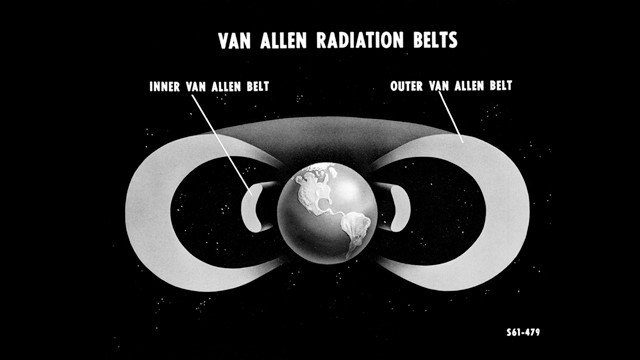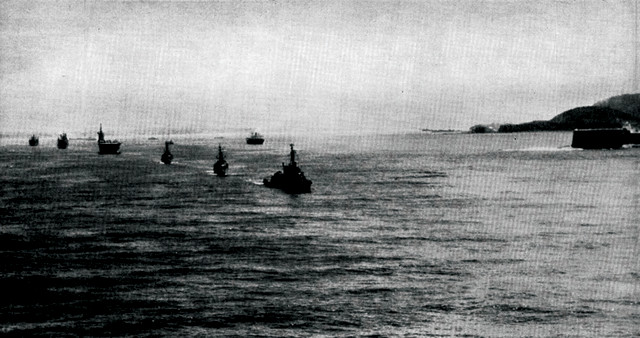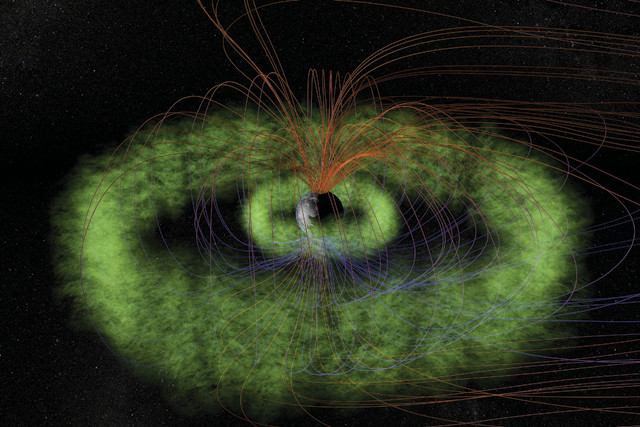
by Sarah Derouin Tuesday, July 3, 2018

The launch of one of the X-17A rockets fired from the USS Norton Sound during Operation Argus. Credit: U.S. Department of Energy.
Sixty years ago this month, a fleet of nine U.S. Navy ships with 4,500 people aboard maneuvered into the Atlantic. Eight of these ships continued to the South Atlantic, about 1,800 kilometers southwest of Cape Town, South Africa, while the ninth headed to the North Atlantic, near the Azores. The clandestine military operation — code-named Operation Argus — was not an invasion, but a scientific mission, carried out at a staggering pace and inspired by an unpublished research paper by an elevator engineer with an interest in accelerator physics.
Secrecy was critical considering the nature of the mission: detonating multiple low-yield nuclear weapons high in the atmosphere to study the explosions’ effects on Earth’s magnetosphere. The task force launched three 1.7-kiloton bombs — one each on Aug. 27, Aug. 30 and Sept. 6, 1958 — detonating them, respectively, at altitudes of 200, 240 and 540 kilometers. The experiments marked the first time that humans altered space weather.
The Argus mission was spurred by the 1958 discovery of highly energetic, charged particle belts encircling the planet and held in place by the magnetosphere. The discovery of an inner belt (1,000 to 6,000 kilometers above Earth) and outer belt (13,000 to 60,000 kilometers above Earth) was made by a team led by University of Iowa astronomer James Van Allen, after whom the belts were then named. The particles in the Van Allen radiation belts can damage electronics and sensors in satellites and spacecraft as these objects pass through. A scientist by the name of Nicholas Christofilos was intrigued not only by the potentially perilous effects on electronics, but also by the possibility that the radiation could also serve a protective role.
Christofilos was born in Boston, Mass., in 1916, and grew up in Greece, where he graduated college with a degree in electrical and mechanical engineering in 1938. During WWII, he worked for an elevator maintenance company in Greece, later starting his own firm. Simultaneously, he continued studying physics on his own time, developing an interest in nuclear physics and particle accelerators.
Christofilos wrote several papers about the “strong focusing principle,” which describes how powerful magnets can be used to focus a beam of charged particles — the principle underlying particle accelerators. However, he never published any of his research in journals — instead, he patented the idea and sent copies of his theories to scientists at the University of California, Berkeley, where “the paper was passed from scientist to scientist without being understood or appreciated,” according to a biography written by A.C. Melissinos. In 1952, while on a visit to the U.S., Christofilos read the paper of a scientific team at Brookhaven National Laboratory that had independently discovered strong focusing. Christofilos rushed to Brookhaven to defend his work. The trip led to a job at Brookhaven, and subsequently at Lawrence Livermore National Laboratory, then known as the Lawrence Radiation Laboratory.
After the discovery of the Van Allen belts, questions emerged about how the belts form and how they might be leveraged for science, technology and national defense. In 1957, while at Lawrence, Christofilos wrote the paper that, together with the discovery of the Van Allen belts, prompted the Argus operation. Christofilos proposed that an atmospheric nuclear blast might create an artificial radiation belt that could be useful for national defense, reasoning that such an explosion would release radiation that would be trapped within the magnetic field lines that run from pole to pole, like the Van Allen belts. If Christofilos’ theory was correct, a blast in the Northern Hemisphere would create a “magnetic conjugate area” where the particles came back down to Earth in the Southern Hemisphere, effectively forming a shield of energized particles. Conversely, detonating nuclear blasts over the South Pacific would create a shield over the United States, protecting the country during an attack.
At the time, Cold War tensions with the Soviet Union were running high, and the idea of exploiting Earth’s magnetic field intrigued the U.S. Department of Defense (DoD). DoD officials wondered if the dome of energized particles could be used defensively, to disable the electronics of incoming enemy aircraft or warheads. Meanwhile, if the trapped particles interfered with communications and enemy outgoing missile launches, then some thought it could also be used as an offensive weapon. If so, setting off explosions over the Indian Ocean might create an offensive shield over Russia, diminishing their military capabilities.
The U.S. Armed Forces Special Weapons Project, the successor to the Manhattan Project, hastily devised Operation Argus to test Christofilos’ theory by detonating nuclear weapons high in the atmosphere and observing how particles shed by the explosion behaved. Although atmospheric nuclear testing had been conducted in the past, at altitudes of tens of meters, Argus would be the first such experiment to take place above the dense atmosphere (troposphere, stratosphere and mesosphere).
Christofilos wanted to test and observe the experiments using satellites, which he said were perfect for measuring both natural and artificial phenomena in the atmosphere.
In April 1958, Task Force 88, commanded by U.S. Navy Rear Admiral Lloyd M. Mustin, was formed to secretly carry out Operation Argus, the planning and execution of which occurred in less than five months. In May, Van Allen instrumented the Explorer IV spacecraft to monitor the blasts, and the satellite launched just a few months later in July 1958.
There was a reason for the haste: a moratorium on atmospheric nuclear tests was slated to go into effect in fall 1958. In a December 1959 report, Mustin wrote: “A sense of urgency was injected into this planning due to the political climate then prevailing, which rendered the future of nuclear testing politically uncertain.”
The team first had to decide where to conduct the testing, and there were several issues to consider. The first was the altitude capability of the X-17A. Launching from the Pacific Proving Grounds would require a more powerful missile to reach the geomagnetic field line needed to test Christofilos’ theory. Launching near the poles, where the desired field line is lower, would risk radiation exposure to the crew. A launch in the South Atlantic placed the detonation at a high-enough altitude for safety, yet still within reach of the X-17A.
The scientists also wanted to avoid a known magnetic field anomaly, the equatorial ionization anomaly, near Brazil. Here, the inner Van Allen radiation belt dips to an unusually low altitude, which would interfere with data collection during the experiment. Choosing a site near South Africa, east of the anomaly location, allowed the beta particles released by the explosion to drift eastward and be measured over most of Earth’s surface before hitting the anomaly. Lastly, the chosen location had to be outside of normal shipping lanes — crucial for safety, security and secrecy.

In August 1958, Operation Argus tested whether high-altitude nuclear explosions could establish artificial radiation belts like the Van Allen radiation belts — giant toroidal bands of radiation that surround Earth. Credit: NASA.
Each of the eight ships sailing for the detonation site in the South Atlantic had a different assignment, including collecting scientific measurements, maintaining security and refueling. The USS Norton Sound was the base for the missile launches. While docked in San Francisco prior to the mission, the ship underwent modifications to support and accommodate the launch of a nuclear weapon from a seagoing vessel — a first.
During testing in July to calibrate measurement and tracking equipment, only two of four missile launches were successful. Despite this, the Norton Sound sailed from port on Aug. 1, traveling around South America and toward the South Atlantic.
Once on location, task force personnel fine-tuned their launch calculations to account for weather, including surface winds — the most vital parameter. To test the adjustments and prepare for the big event, four modified Deacon rockets were launched from the Norton Sound. Missile tracking and observation equipment was checked and adjusted one last time, and then the mission was given a go.
On Aug. 27, 1959, Argus 1 — the first nuclear device — was launched from the deck of the Norton Sound. Those on the ships saw a “horizon-wide flash brighten the cloud layer,” while a pilot flying at about 6,700 meters reported seeing “a great luminous ball,” according to a report of the tests prepared by the Defense Nuclear Agency. “For the next 30 minutes the aircrew observed and photographed an awesome auroral display as colors and shapes changed.”
In a 1959 paper, Christofilos wrote: “The initial flash of the burst was followed by an auroral luminescence extending upward and downward along the magnetic line where the burst occurred. Simultaneously, at the point where the same magnetic line returns to Earth’s atmosphere (the so-called conjugate point) in the North Atlantic, another auroral luminescence appeared in the night sky near the Azores Islands.”
Over the next nine days, two more detonations were conducted at higher altitudes.
All three blasts were monitored by satellites, aircraft and instruments on ships near the launch site and near the magnetic conjugate area. The monitoring effort involved dozens of scientists from multiple labs, including Stanford’s Radio Propagation Laboratory and MIT’s Lincoln Laboratory.
The results all pointed to the same conclusion: within an hour of detonation, each of the Argus explosions caused the formation of an artificial electron layer in the exosphere. The high-energy electron shells were clearly observed by the instruments aboard the Explorer IV satellite, which measured electron content within the artificial belts over time.

U.S. Navy Task Force 88 leaves Rio de Janeiro, Brazil, with the aircraft carrier USS Tarawa in 1958. Documentation indicated the special anti-submarine warfare task group was on a mission to collect hydrographical data, but the task force was actually conducting Operation Argus in the South Atlantic Ocean. Credit: U.S. Department of Defense.
The artificial shells created by the Argus 1 and 2 blasts each lingered about three weeks, while the shell produced by Argus 3 lasted about a month. Natural geomagnetic storms that happened to strike shortly after the first two tests likely disrupted those shells earlier than they would have dispersed on their own, researchers concluded.
Although the artificial shells did indeed form and interfere with electronics, as Christofilos predicted, they were deemed too short-lived to be of use for military actions. Nonetheless, Operation Argus gave researchers invaluable information.
Van Allen published summary papers on observational data from Operation Argus, reporting that the bomb-produced electrons showed a different spectrum of energy from “natural” electrons, making them easily identifiable.
In 1959, Van Allen wrote to President Eisenhower that the Argus experiments “… undoubtedly constitute the greatest geophysical experiment ever conducted by man. The observations have great significance in understanding the nature of the geomagnetic field, the mechanisms of trapping of particles in the geomagnetic field, the origin of aurorae and magnetic storms, and the density of the very high atmosphere.”
Van Allen urged that the results of the secret mission be released to the scientific community and the public. A few weeks later, details of the mission, including a short movie about the operation, were released. The press coverage mirrored Van Allen’s assessment, with the New York Times dubbing the operation the “greatest scientific experiment ever conducted,” and an article in Life magazine titled “Triumph in Space for a ‘Crazy Greek.'”

Our understanding of the Van Allen radiation belts (green) and Earth's magnetic field (blue and red) was informed by Operation Argus. Credit: T. Benesch and J. Carns for the NASA Science Mission Directorate.
Today, atmospheric nuclear testing to create human-induced space weather no longer occurs. However, 60 years after Operation Argus, these early experiments continue to serve as an important reference point for scientists in understanding more about radiation belts and space weather.
© 2008-2021. All rights reserved. Any copying, redistribution or retransmission of any of the contents of this service without the expressed written permission of the American Geosciences Institute is expressly prohibited. Click here for all copyright requests.